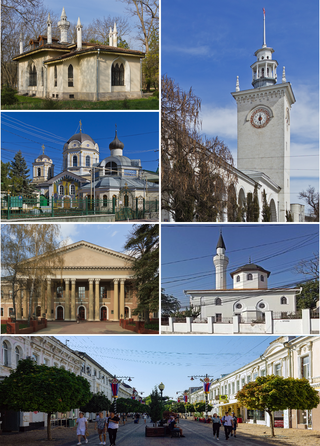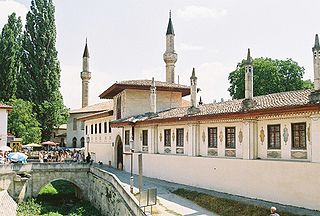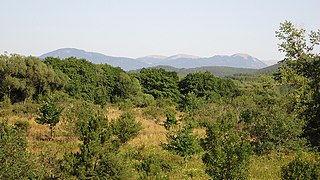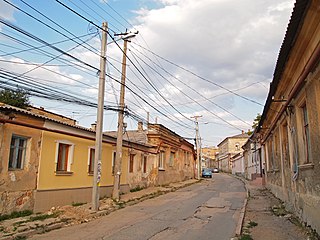
The Seyit-Settar Mosque (Crimean Tatar : Seyit-Settar Cami) is a mosque (cami) in Old Simferopol neighborhood of Simferopol, Crimea. [1]

The Seyit-Settar Mosque (Crimean Tatar : Seyit-Settar Cami) is a mosque (cami) in Old Simferopol neighborhood of Simferopol, Crimea. [1]
Records indicate that the mosque was funded in 1850 by the then Simferopol city mayor, merchant Seyit Settar Çelebi . [2] [3]
During the Great Purge, the mosque was abandoned by the religious community under fear of reprisals by the Bolsheviks. In 1990s during the massive return of Crimean Tatars from the exile the mosque was reopened. [3]
In 2014 the old building was demolished. Before that, in 2013 the city council allocated 0.4452 hectares of territory adjacent to the mosque to the Spiritual Administration of the Muslims of Crimea for the reconstruction of the building and the construction of a madrasah, an administrative building and a building for students. [4] The new mosque, constructed over the old basement, was inaugurated in 2016. [3]

Crimea is a peninsula in Eastern Europe, on the northern coast of the Black Sea, almost entirely surrounded by the Black Sea and the smaller Sea of Azov. The Isthmus of Perekop connects the peninsula to Kherson Oblast in mainland Ukraine. To the east, the Crimean Bridge, constructed in 2018, spans the Strait of Kerch, linking the peninsula with Krasnodar Krai in Russia. The Arabat Spit, located to the northeast, is a narrow strip of land that separates the Syvash lagoons from the Sea of Azov. Across the Black Sea to the west lies Romania and to the south is Turkey. The population is 2.4 million, and the largest city is Sevastopol. The region has been under Russian occupation since 2014.

Simferopol, also known as Aqmescit, is the second-largest city on the Crimean Peninsula. The city, along with the rest of Crimea, is internationally recognised as part of Ukraine, and is considered the capital of the Autonomous Republic of Crimea, but currently is under the de facto control of Russia, which annexed Crimea in 2014 and regards Simferopol as the capital of the Republic of Crimea. Simferopol is an important political, economic and transport hub of the peninsula, and serves as the administrative centre of both Simferopol Municipality and the surrounding Simferopol District. Its population was 332,317 .

Bakhchysarai is a town in the Autonomous Republic of Crimea, Ukraine. It is the administrative center of the Bakhchysarai Raion (district), as well as the former capital of the Crimean Khanate. Its main landmark is Hansaray, the only extant palace of the Crimean Khans, currently open to tourists as a museum. Population: 27,448 .

The Crimean Khanate self-defined as the Throne of Crimea and Desht-i Kipchak and in old European historiography and geography known as Little Tartary, was a Crimean Tatar state existing from 1441–1783, the longest-lived of the Turkic khanates that succeeded the empire of the Golden Horde. Established by Hacı I Giray in 1441, it was regarded as the direct heir to the Golden Horde and to Desht-i-Kipchak.

Islam in Ukraine is a minority religious affiliation with Muslims representing around 5% of the total population as of 2016. The religion has a long history in Ukraine dating back to Berke Khan of the Ulug Ulus in the 13th century and the establishment of the Crimean Khanate in the 15th century.

Bilohirsk is a town and the administrative centre of Bilohirsk Raion, one of the raions (districts) of the Autonomous Republic of Crimea, which is recognised by a majority of countries as part of Ukraine, but is occupied by Russia. Population: 16,354 .
The Crimea Germans were ethnic German settlers who were invited to settle in the Crimea as part of the Ostsiedlung.

Simferopol City Municipality is one of the 25 regions of the Crimean peninsula in Ukraine currently occupied by Russia. Population: 352,363 .

Simferopol International Airport is an airport located in Simferopol, de facto the capital of the Republic of Crimea. Built in 1936, the airport today has one international terminal and one domestic terminal.

The Khan's Palace or Hansaray is located in the town of Bakhchysarai, Crimea. It was built in the 16th century and became home to a succession of Crimean Khans. The walled enclosure contains a mosque, a harem, a cemetery, living quarters and gardens. The palace interior has been decorated to appear lived in and reflects the traditional 16th-century Crimean Tatar style. It is one of the best known Muslim palaces found in Europe, alongside the Sultan palaces of Istanbul and the Alhambra in Spain.
Çelebi or Chelebi may refer to:

Simferopol Raion is one of the 25 regions of the Crimean peninsula, administered by Russia, but considered by many countries as part of Ukraine. The administrative center of the raion is the city of Simferopol which is incorporated as a town of republican significance and is not a part of the district. The Simferopol Raion is situated in the central part of the peninsula. Population: 152,091 .

The Kebir Mosque is located in Simferopol, Crimea. The Kebir Mosque is a prominent architectural monument in Simferopol and the oldest building in the city.

The Tahtali-Jami Mosque is located in Bakhchysarai, Crimea. In Crimean Tatar: Tahtalı Cami means "wooden mosque".

Orta Cami Mosque is one of the oldest mosques in Crimea. It is situated on the modern day Lenina Street in the old town of Bakhchisaray.

The Republic of Crimea is a republic of Russia, comprising most of the Crimean Peninsula, but excluding Sevastopol. Its territory corresponds to the pre-2023 territory of the Autonomous Republic of Crimea, a de jure subdivision of Ukraine. Russia occupied and annexed the peninsula in 2014, although the annexation remains internationally unrecognized.

Aqmescit Friday Mosque, also known as the Great Friday Mosque and the Simferopol Cathedral Mosque named after Noman Çelebicihan is the largest mosque in Aqmescit (Simferopol), Crimea, which had been under construction since 2015 after Russian annexation of the Crimean peninsula. It opened on 9 December 2023.

Ahrarne is an urban-type settlement located in Simferopol Municipality, Crimea. Population: 3,754 .

Old Simferopol, known locally as the Old Town, is an area of the city of Simferopol which until the end of the 18th century served as the centre of the city of Aqmescit. The old town consists of narrow, short streets constructed in a traditional Turkic style. In the 19th century it was also referred to by travellers as the "Asian town" because of the contrast with Simferopol's other regular, European-style neighbourhoods. Today, some of the neighbouring 19th-century, single-storey, European-style buildings are also considered to be part of the old town. The area is bounded by Lenin, Sevastopol's'ka, Krylov, and Chervonoarmiis'ka streets. The population of the old town is approximately 50,000.

Partenit Mosque is destroyed mosque in urban-type settlement Partenit in Crimean peninsula. A monument of the cultural heritage of Ukraine No. UA-01-103-0047.